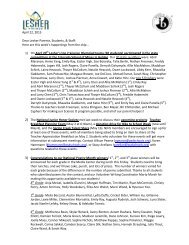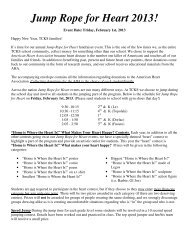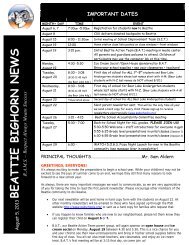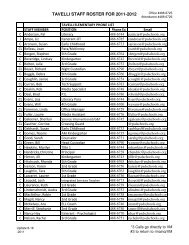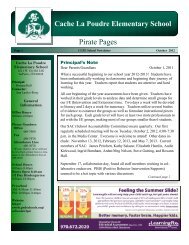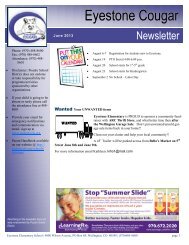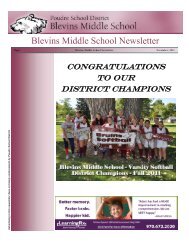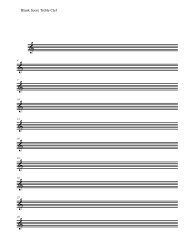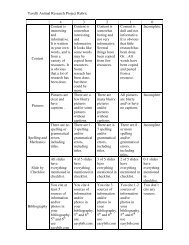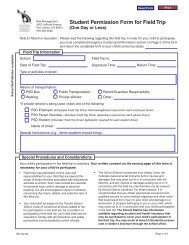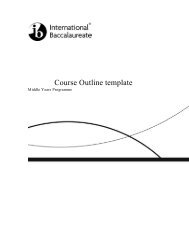Professional Learning Communities and the NCA School ...
Professional Learning Communities and the NCA School ...
Professional Learning Communities and the NCA School ...
You also want an ePaper? Increase the reach of your titles
YUMPU automatically turns print PDFs into web optimized ePapers that Google loves.
<strong>Professional</strong> <strong>Learning</strong> <strong>Communities</strong> <strong>and</strong> <strong>the</strong> <strong>NCA</strong> <strong>School</strong> Improvement Process<br />
By: Janice K. Colliton, Ph.D.<br />
About <strong>the</strong> Author: Janice K. Colliton served public education for 32 years working as a classroom teacher,<br />
staff development coordinator, principal of two state <strong>and</strong> national Blue Ribbon <strong>School</strong>s, <strong>and</strong> assistant<br />
superintendent of instructional services for a large district. Currently, she is an <strong>NCA</strong> Ambassador <strong>and</strong><br />
educational consultant.<br />
<strong>School</strong>s across <strong>the</strong> <strong>NCA</strong> network are using professional learning communities as a tool to<br />
improve classroom instruction. This article examines <strong>the</strong> strong relationship between <strong>the</strong><br />
<strong>NCA</strong> school improvement process <strong>and</strong> professional learning communities. Toge<strong>the</strong>r, <strong>the</strong><br />
two provide a powerful combination to ensure that no child is left behind.<br />
Introduction & Definitions<br />
A professional learning community (PLC) is a group of professionals working <strong>and</strong> learning<br />
toge<strong>the</strong>r to ensure high levels of learning for ALL students. The characteristics of a<br />
professional learning community are:<br />
1. shared mission, vision, values <strong>and</strong> goals that are embedded in <strong>the</strong> hearts <strong>and</strong> minds<br />
of people throughout <strong>the</strong> organization;<br />
2. collective inquiry - <strong>the</strong> engine of professional growth <strong>and</strong> renewal;<br />
3. collaborative teams - <strong>the</strong> organizational structure that supports improvement in<br />
student learning;<br />
4. action orientation that focuses on results versus good intentions; <strong>and</strong><br />
5. an underst<strong>and</strong>ing that continuous improvement in teacher <strong>and</strong> student learning is <strong>the</strong><br />
way business is done in schools not a task to complete (DuFour & Eaker, 1998).<br />
Do <strong>the</strong>se characteristics sound familiar <strong>NCA</strong> CASI bases its school improvement process<br />
on <strong>the</strong> same set of characteristics. Research on effective methods for improving schools is<br />
embedded in <strong>the</strong> <strong>NCA</strong> school improvement process. <strong>NCA</strong> has worked with schools for<br />
several decades to put <strong>the</strong>se characteristics of improvement into practice at <strong>the</strong> school level.<br />
DuFour <strong>and</strong> Eaker (1998) have been successful in implementing <strong>the</strong>se concepts at <strong>the</strong><br />
grade/course level. Working at complementary levels – <strong>the</strong> school <strong>and</strong> classroom, <strong>the</strong> <strong>NCA</strong><br />
school improvement <strong>and</strong> PLC processes reinforce <strong>and</strong> streng<strong>the</strong>n one ano<strong>the</strong>r. They are not<br />
mutually exclusive, but ra<strong>the</strong>r mutually supportive. If we want to ensure that no child is left<br />
behind, we must underst<strong>and</strong> <strong>the</strong> important relationship between <strong>the</strong> <strong>NCA</strong> school<br />
improvement process <strong>and</strong> PLC.<br />
Three Critical Questions<br />
Three critical questions are central to our work as educators. Those questions are:<br />
1. What do we want our students to know <strong>and</strong> be able to do (curriculum)<br />
2. How will we know our students are learning (assessment)<br />
3. What will we do if our students are not learning (strategies/interventions)<br />
Over <strong>the</strong> past several years, DuFour <strong>and</strong> Eaker (1998) have brought <strong>the</strong>se three questions to<br />
<strong>the</strong> forefront of our consciousness in <strong>the</strong>ir work with <strong>the</strong> concepts related to professional
learning communities. However, <strong>the</strong>se are not new questions. These questions are at <strong>the</strong><br />
heart of <strong>the</strong> <strong>NCA</strong> school improvement process, a professional learning community at <strong>the</strong><br />
school level. If we are to have a comprehensive, systemic approach to school improvement<br />
we must ask <strong>the</strong>se questions at <strong>the</strong> district, school, <strong>and</strong> classroom levels (Glatthorn, 1994).<br />
What do we want our students to know <strong>and</strong> be able to do<br />
The district’s job, with input from stakeholders, is to create a curriculum blueprint for all of<br />
its schools. A quality curriculum is achieved by focusing on mastery objectives, limiting<br />
scope <strong>and</strong> sequence, recommending best instructional practices, <strong>and</strong> providing support for<br />
implementation of identified curriculum. When <strong>the</strong> curriculum is received at <strong>the</strong> school<br />
level, it is important to map <strong>the</strong> curriculum horizontally <strong>and</strong> vertically to guarantee that all<br />
children will have <strong>the</strong> opportunity to learn <strong>the</strong> required curriculum (Marzano, 2003).<br />
This discussion at <strong>the</strong> school level is a vital part of <strong>the</strong> <strong>NCA</strong> school improvement process.<br />
Teachers take into consideration assessment data that allows <strong>the</strong>m to know <strong>the</strong><br />
strengths/weaknesses of <strong>the</strong> students in <strong>the</strong>ir school. From this data, school-wide<br />
improvement goals emerge. When grade/course teachers know <strong>the</strong> required curriculum <strong>and</strong><br />
<strong>the</strong> areas of students’ strengths/ weaknesses, <strong>the</strong>y are able to plan <strong>the</strong>ir daily lessons. These<br />
lessons address school improvement goals <strong>and</strong> o<strong>the</strong>r learning needs of students as identified<br />
by <strong>the</strong> grade/course level teacher.<br />
When teams of grade/course level teachers meet in <strong>the</strong>ir regularly scheduled PLC, <strong>the</strong>y can<br />
review student achievement data, identify student needs, <strong>and</strong> determine how to best meet<br />
those needs. The use of PLC at <strong>the</strong> classroom level has dramatically increased teacher’s<br />
ability to implement a guaranteed <strong>and</strong> viable curriculum, monitor student progress with<br />
colleagues on school improvement goals <strong>and</strong> curriculum objectives, <strong>and</strong> improve <strong>the</strong><br />
teaching <strong>and</strong> learning process. The strong link between school improvement goals <strong>and</strong> PLC<br />
at <strong>the</strong> classroom level allows all children to be successful.<br />
How will we know our students are learning<br />
Many districts involved in <strong>the</strong> <strong>NCA</strong> school improvement process have developed K – 12<br />
assessment plans. This allows schools to use <strong>the</strong> data provided to monitor improvement in<br />
student learning related to <strong>the</strong> achievement of <strong>the</strong>ir school improvement goals. Of course,<br />
<strong>the</strong>re is more student assessment needed at <strong>the</strong> school <strong>and</strong> classroom level if students are to<br />
be successful learners. Stiggins (2001), a nationally known leader in classroom assessment,<br />
asserts that educators need to underst<strong>and</strong> when to use assessments for evaluations of<br />
programs <strong>and</strong> how to use student-centered classroom assessments that guide students to<br />
improve <strong>the</strong>ir learning.<br />
<strong>School</strong>s that are involved in <strong>the</strong> <strong>NCA</strong> school improvement process make time for staff<br />
development to ensure that teachers are engaged in developing or using assessments of<br />
learning (program evaluation) <strong>and</strong> assessments for learning (performance assessments).<br />
When assessment data is reviewed at <strong>the</strong> school level, improvement plans are updated as<br />
necessary. When grade/course level teams share assessment data, it allows colleagues to<br />
improve <strong>the</strong> teaching <strong>and</strong> learning process in <strong>the</strong>ir classrooms. Linking <strong>the</strong>se discussions<br />
solves <strong>the</strong> problem as to how to implement strategies outlined in <strong>the</strong> school improvement
plan. In fact, some <strong>NCA</strong> schools are now identifying PLC as <strong>the</strong> major organizational<br />
structure for implementing <strong>the</strong> strategies of <strong>the</strong> school improvement plan.<br />
What will we do if our students are not learning<br />
The district plays an important role in identifying best instructional practices. Best practices<br />
are embedded in <strong>the</strong> curriculum development process <strong>and</strong> communicated to schools. Based<br />
on a school’s improvement goals, staff selects practices (strategies/interventions) that need<br />
to be implemented at <strong>the</strong>ir school. <strong>Professional</strong> development, both group <strong>and</strong> individual, is<br />
provided. Within <strong>the</strong> grade/course PLC teams, colleagues can also support each o<strong>the</strong>r as<br />
new practices are implemented. Through teamwork, members of <strong>the</strong> PLC may also discover<br />
new ways to address school improvement <strong>and</strong> individual student learning goals.<br />
What happens to students when <strong>the</strong> district, school <strong>and</strong>/or classroom teacher fails to<br />
ask <strong>the</strong>se three critical questions<br />
If at any level <strong>the</strong> three questions are not addressed, <strong>the</strong>re will be students who fall through<br />
<strong>the</strong> cracks. For example, school boards set graduation requirements. Once <strong>the</strong>se graduation<br />
requirements are determined, <strong>the</strong> district develops curriculum that maps out essential<br />
learning for each required course. This opens <strong>the</strong> door for a guaranteed curriculum for all<br />
students across all schools. If this does not occur, it is possible for inconsistent<br />
implementation of identified st<strong>and</strong>ards <strong>and</strong> benchmarks to occur creating an equity issue for<br />
students between school buildings. At each building, <strong>the</strong> school improvement team also<br />
needs to ensure that curriculum requirements are communicated to staff <strong>and</strong> curricular goals<br />
are coordinated <strong>and</strong> achieved at each grade/course level. Lastly, it is important that<br />
grade/course teaching teams monitor student achievement of <strong>the</strong> curriculum <strong>and</strong> work<br />
toge<strong>the</strong>r to effectively implement best practice to address individual student needs.<br />
Advantages of Systemic <strong>School</strong> Improvement<br />
When we underst<strong>and</strong> that <strong>the</strong> three critical questions need to be asked <strong>and</strong> acted upon at all<br />
three levels of <strong>the</strong> organization (district, school <strong>and</strong> classroom), no child will left behind.<br />
Underst<strong>and</strong>ing <strong>the</strong> roles <strong>and</strong> responsibilities at each level <strong>and</strong> how <strong>the</strong>y interact will ensure<br />
equity for all students (guaranteed curriculum/ opportunity to learn) <strong>and</strong> improve <strong>the</strong> overall<br />
quality of <strong>the</strong> school program for all students. When all stakeholders in <strong>and</strong> related to <strong>the</strong><br />
organization are focused on achieving <strong>the</strong> mission that all children will learn, schools <strong>and</strong><br />
classrooms are transformed. There is potential for achievement gaps to close while<br />
continuing to improve <strong>the</strong> entire learning process for all students. Resources such as staff<br />
development, common assessments, <strong>and</strong> financial support can be targeted to meet specific,<br />
well-articulated needs.<br />
<strong>NCA</strong> <strong>and</strong> PLC play important, supporting roles in answering <strong>the</strong> three critical questions.<br />
The two go h<strong>and</strong> in h<strong>and</strong>. The <strong>NCA</strong> school improvement process focuses on <strong>the</strong> school as<br />
a whole giving guidance to classroom teachers. Through professional learning communities,<br />
teachers can take that guidance <strong>and</strong> collaborate with one ano<strong>the</strong>r to identify <strong>and</strong> make<br />
necessary changes in <strong>the</strong>ir instruction to achieve individual student <strong>and</strong> school-wide goals.
References:<br />
DuFour, R. & Eaker, R. (1998). <strong>Professional</strong> learning communities at work: Best practices<br />
for enhancing student achievement. Bloomington, IN: National Educational Service.<br />
Glatthorn, A.A. (1994). Developing a quality curriculum. Alex<strong>and</strong>ria, VA: Association for<br />
Supervision <strong>and</strong> Curriculum Development.<br />
Marzano, R. J.(2003). What works in schools: Translating research into action. Alex<strong>and</strong>ria,<br />
VA: Association for Supervision <strong>and</strong> Curriculum Development.<br />
North Central Association Commission on Accreditation <strong>and</strong> <strong>School</strong> Improvement (2001).<br />
Implementing <strong>the</strong> <strong>NCA</strong> school improvement process: Challenging schools to prepare each<br />
student for life’s transitions. Tempe, AZ: <strong>NCA</strong> CASI.<br />
Stiggins, R. J. (2001). Student-involved classroom assessment, 3 rd edition. Upper Saddle<br />
River, NJ: Prentice-Hall, Inc.



